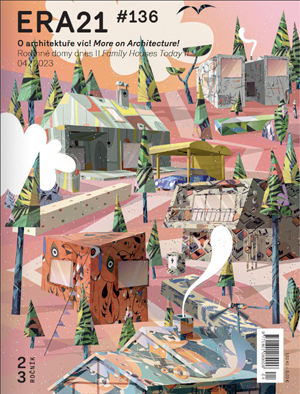Cenu časopisu ERA21 v rámci Young Architect Award 2017 převzala Monika Jasioková za práci Nové struktury ve starých stopách | Bílá labuť, zpracovanou v ateliéru Emila Přikryla na AVU v Praze. Status ceny časopisu ERA21 je definován jako "cena za kvalitní prezentaci zvolené architektonické myšlenky, nikoliv v efektní grafické podobě, ale ve smyslu sdělnosti, přesvědčivosti a srozumitelnosti odborné i laické veřejnosti."
» entire articleStavbám vzniklým v období socialismu se dnes začíná dostávat pozornosti a přestávají být a priori odmítané. Procházka navazuje na téma „Výpadek paměti“ zpracované v časopise ERA21 #03/2017.
Příklady kvalitní architektury 60.– 80. let 20. století v Českých Budějovicích navštívíme s architektem Filipem Landou, šéfredaktorem časopisu ERA21, a památkářkou Evou Erbanovou z NPÚ. Na programu bude budova Jihočeské vědecké knihovny na Lidické třídě (dříve Muzeum dělnického hnutí) včetně výstavy soutěžních návrhů na dostavbu tohoto objektu, dále stavby Bohumila Böhma (Plavecký stadion a Koldům) a nějaké další bonusy cestou. Sraz je v 15:00 před budovou JČVK na Lidické třídě.
» entire articlePo úspěšném, už 6. ročníku nejkreativnějšího a nejinteraktivnějšího festivalu KDE BOLO, TAM BOLO..., který se konal v Bratislavě a Žilině, zavítal festival i do Brna! Pro školní děti byl připraven wokrshop plný kreativity se známými architekty a umělci. ERA21 jako mediální partner nemohla chybět.
» entire articleV krátkém experimentu nazvaném architektonické vzdělávání se musíme ptát: Jak dlouho ještě vydrží ateliérový model? Otázka se týká přímo podstaty naší činnosti. Při pomyšlení na ateliér má člověk tušení konce. Od pozdních šedesátých a raných sedmdesátých let, kdy byl tento výukový model vynalezen a kdy byl na vrcholu rozkvětu, do situace zasáhly mnohé vlivy. Přesto dnes stále tvrdohlavě a bezmyšlenkovitě pokračujeme v této „nové” tradici. O ateliéru uvažujeme jako o centru architektonického vzdělávání. Je však dále udržitelné? Kolik podmínek se v architektonickém vzdělávání změnilo od doby, kdy byl tento postoj formulován? Je možné dnes najít jiný přístup, který by lépe vyhovoval okolnostem, s nimiž se dnes musíme vyrovnávat?
» entire articleEleven years ago ERA21 (#01/2006) published a quotation from an essay I wrote entitled Five Critical Horizons for Architectural Educators in an Age of Distraction. The essay proposed the studio model itself was subject to various distractions that would either question the model or cause new models to emerge. I was convinced at that time and even more so today the level of distractions have increased and further lessened the efficacy of the modern or post-modern studio model. Historically the studio model depended on “masters” who somewhat cryptically shared their methods to willing acolytes.
» entire article

ERA21 vydává ERA Média, s. r. o. |
|
|
Phone: +420 530 500 801 E-mail: redakce@era21.cz |
|
| WEBdesign Kangaroo group, a.s. |